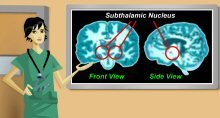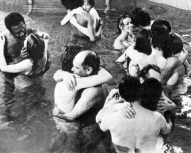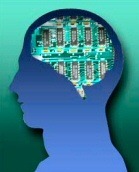Tom Stafford's Blog, page 123
September 27, 2010
Neurosurgery simulated
 Ohio State University have created a fantastic interactive web application where you play the part of a neurosurgeon operating on a patient who needs a deep brain stimulation device installed to treat their Parkinson's disease.
Ohio State University have created a fantastic interactive web application where you play the part of a neurosurgeon operating on a patient who needs a deep brain stimulation device installed to treat their Parkinson's disease.
When I first loaded it up and saw the cartoon-like style I thought it would just be a bit of eye-candy but it turns out to be quite a detailed guide to exactly how this sort of surgery is undertaken.
It's great if you're just curious, as there's plenty to learn about the procedure, but even if you're a neuroscience fanatic there are questions throughout the demo that allow you to flex your problem-solving skills.
I have to say, I learnt loads from it, and the best bit is where you get to hear the firing patterns of different areas as the recording electrode is inserted.
A cleverly designed and engaging bit of software.
Link to EdHeads deep brain stimulation neurosurgery demo.








Psychotherapist to the dangerously disturbed
 The Independent has a revealing article on the working life of Dr Gwen Adshead, a forensic psychiatrist and psychotherapist at Broadmoor Hospital, one of the few very high security hospital dedicated to the most dangerous psychiatric patients in the UK.
The Independent has a revealing article on the working life of Dr Gwen Adshead, a forensic psychiatrist and psychotherapist at Broadmoor Hospital, one of the few very high security hospital dedicated to the most dangerous psychiatric patients in the UK.
As a consultant forensic psychotherapist – a rare breed in medicine – she spends her working life in the company of men at Broadmoor whom others would dismiss with a single word – evil. Her aim is to make them safer – safe enough, ultimately, to be released from Britain's highest security institution for mentally disordered offenders – and to achieve that they must understand the full import of the crime they have committed.
"My job is to help a man become more articulate about what he has done, about his illness and about why that might be important for his future. Even if a cure is not possible, recovery of some identity is possible. My work involves talking to them and getting them to become more self-reflective. Violence is more likely to occur when people are not thinking straight."
Admission to Broadmoor is granted only to members of an exclusive club: the violent insane. The Yorkshire Ripper, Peter Sutcliffe, is here, convicted in 1981 of murdering 13 prostitutes; Kenneth Erskine, the Stockwell strangler who murdered seven elderly people in 1986; and London nail bomber David Copeland who targeted blacks, Bangladeshis and gays, killing three people and injuring 129, of whom four lost limbs.
The article characterises the patients Adshead works with as the 'violent insane' although it's worth noting that not all will be 'insane' in the popular or even traditional sense of the term – that is, affected by psychosis that includes delusions and hallucinations.
Some will be 'diagnosed' with Dangerous and Severe Personality Disorder. I put 'diagnosed' in scare quotes because you may notice that no such condition is listed in either the DSM or ICD diagnostic manuals – it has been created by the UK government and on the basis of this label a patient can be locked-up indefinitely.
Unlike psychosis, personality disorder doesn't involve any significant 'loss of contact with reality' (although it may be diagnosed alongside it). This is why the journalist comments that the patient he bumps into who makes "a passionate denunciation" of his detention doesn't seem to be 'insane'.
This is not to say he's just a regular chap – a diagnosis of personality disorder signifies his day-to-day functioning is quite impaired because of difficulties relating to others – while the 'dangerous and severe' prefix is based on a still-not-very-accurate risk assessment that the person is likely to be violent in the near future.
The Broadmoor DSPD unit has now been in existence for 10 years and still lacks good evidence that it is effective in helping the patients or reducing risk. Needless to say, it is likely to remain controversial.
The Independent article is a good insight into the difficulties of working with (the very few) psychiatric patients who are dangerous, regardless of diagnosis, although do ignore the sensationalist and irrelevant headline. Apart from that, well worth a read.
Link to Independent on Adhead and Broadmoor.








September 25, 2010
Racism: the board game
 In 1970 Psychology Today published a board game where players where divided into white and black, and had to make economic progress while competing with each other. Called 'Blacks and Whites' and based on Monopoly, the idea was to demonstrate how the odds were stacked against black people in society by having different rules for each race in the game.
In 1970 Psychology Today published a board game where players where divided into white and black, and had to make economic progress while competing with each other. Called 'Blacks and Whites' and based on Monopoly, the idea was to demonstrate how the odds were stacked against black people in society by having different rules for each race in the game.
It was Whites started out with $1 million, blacks with $10,000 and each race had different opportunity decks. While whites could buy property...
September 24, 2010
Cultures of friendship
 Neuroanthropology has an all-too-brief interview on how different cultures around the world have fundamentally different ideas about what it means to be a friend.
Neuroanthropology has an all-too-brief interview on how different cultures around the world have fundamentally different ideas about what it means to be a friend.
The interviewee is anthropologist Dan Hruschka who has just written a book summarising his research on the anthropology of friendship.
It's a wonderfully simple idea but really challenges some of our core assumptions about social relationships:
Can you describe one of your examples that really makes us think differently about...
Online therapy: a download off your mind
 What's it like doing psychotherapy in Second Life? New Scientist has a level-headed article that describes how personal therapeutic interactions are altered by the online world and how this may be a benefit for people with certain types of problems.
What's it like doing psychotherapy in Second Life? New Scientist has a level-headed article that describes how personal therapeutic interactions are altered by the online world and how this may be a benefit for people with certain types of problems.
In my limited experience of Second Life, I was struck by how many people were offering commercial counselling services, many without apparent qualifications, and I've seen been a bit sceptical since.
The NewSci piece is by a professional counsellor ...
2010-09-24 Spike activity
Quick links from the past week in mind and brain news:

The Guardian has a great piece on the attempts to create a brain-wave-based criminal-catching lie detector and why the technology hasn't yet matched the hype.
I've been thoroughly enjoying the excellent NeuroShrink blog recently. The latest post explores the link between Viagra and a transient but poorly understood form of amnesia.
Wired UK has a brief piece on how 'scientists can read your face like a data-filled book'. In other words...
What do mad scientists study?
 io9 has a fantastic piece that analyses the favoured subjects of investigation for mad scientists – tracking trends in 200 years of fictional evil research.
io9 has a fantastic piece that analyses the favoured subjects of investigation for mad scientists – tracking trends in 200 years of fictional evil research.
The researchers from io9′s underground science bunker scanned films and literature for depictions of the slightly unbalanced investigator to look at how research topics varied as fashions changed.
So what did we discover? First of all, mad scientists have obviously grown in popularity a great deal since the nineteenth century. Of all the...
September 23, 2010
Nude psychotherapy and the quest for inner peace
 The first session of nude psychotherapy was held in 1967, at a nudist resort in California. It was the brainchild of radical therapist and ordained minister Paul Bindrim who made headlines around the world with events intended to enhance emotional connectedness and dismantle body-image hangups.
The first session of nude psychotherapy was held in 1967, at a nudist resort in California. It was the brainchild of radical therapist and ordained minister Paul Bindrim who made headlines around the world with events intended to enhance emotional connectedness and dismantle body-image hangups.
Despite the massive interest at the time, 'nude psychotherapy' would have largely disappeared from the history of psychology if it weren't for a truly amazing article by historian Ian Nicholson...
September 22, 2010
Watch the skies
 The BBC World Service has an excellent documentary that visits the SETI Institute, a project that is scanning for skies for signs of extraterrestrial intelligence.
The BBC World Service has an excellent documentary that visits the SETI Institute, a project that is scanning for skies for signs of extraterrestrial intelligence.
The occasion is the 50th anniversary of the Drake equation, a mathematical formula that attempts to estimate the number of alien civilisations that exist in the universe.
On one hand, it's quite charming (admittedly, in a slightly patronising way) to think of scientists earnestly looking for aliens from outer space, but on the...
Towards an operating system for brain hacking
 Electronic devices that interface directly with the brain are now being produced by labs around the world but each new device tends to work in a completely different way. An article in Technology Review argues that we need an agreed neural operating system so brain-machine interfaces can more easily work together.
Electronic devices that interface directly with the brain are now being produced by labs around the world but each new device tends to work in a completely different way. An article in Technology Review argues that we need an agreed neural operating system so brain-machine interfaces can more easily work together.
Although current devices tend only to measure brain activity or stimulate cortical areas, it won't be very long before devices typically do both – detecting and reacting to neural...
Tom Stafford's Blog
- Tom Stafford's profile
- 13 followers



